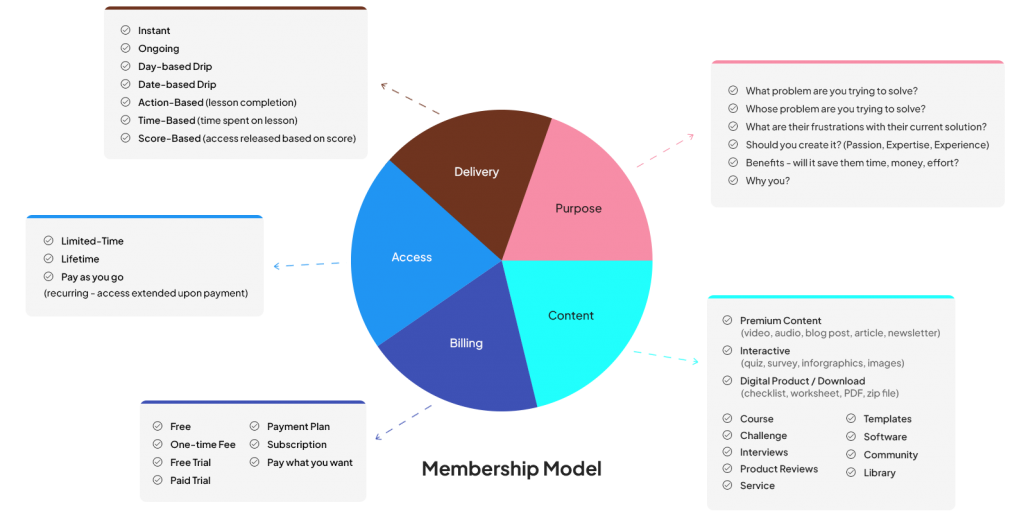Before starting a membership site, it’s crucial to clarify the purpose and ensure that your offering aligns with the needs of your target audience. The membership model is built around five core components: Purpose, Content, Delivery, Access, and Billing. Each component addresses critical aspects of creating a membership or product that engages and delivers value to your audience.

Step 1: Purpose of your Membership Site
Here are the key questions to answer to shape your membership site for success! Write down answer to all of these questions in as much detail as you can before you build your membership site! This will help you create better products and also he
☑️What problem are you trying to solve?
Clearly define the core issue or pain point that your membership site will address.
- Is it related to education, skill-building, access to exclusive content, community support, or all of these?
- Be specific: What is missing in the market or what do you feel strongly about that people need?
☑️ Whose problem are you solving?
Identify your target audience. Understanding your audience is crucial to tailor your content and marketing.
- Who is your ideal member?
- What are their main goals?
- How will your content or product fit into their daily lives or business activities?
☑️ What are their frustrations with current solutions?
Conduct research to discover what solutions already exist and why they might fall short.
- What are the common complaints or gaps in existing services?
- Are competitors not offering enough depth, personalization, or quality?
- Knowing where others fail gives you the advantage to create something better.
☑️Should you create it?
Evaluate your own passion, expertise, and experience.
- Are you genuinely excited about this problem and driven to solve it?
- Do you have the knowledge, experience or skills necessary to deliver a high-quality solution?
- Consider your long-term interest in the subject—passion is key to sustaining your efforts in a membership site.
☑️ What are the benefits?
Define how your membership will improve the lives of your audience.
- Will it help them save time, money, or effort?
- Does it provide value in ways that current solutions do not—such as better access, superior content, or personalized interaction?
- Think about tangible outcomes: Will they learn a new skill, grow their business, or find a supportive community?
☑️ Why you?
Establish your unique value.
This is about building authority and showing why your approach is distinct and valuable.
What makes you the right person to solve this problem?
What’s your story, background, or expertise that gives you credibility in this area?
Why should your audience trust you and pay for your membership?
Step 2. Content
Description: Content is what your users get when they signup for your product or service. It defines the value you deliver to your audience and can come in various forms (course, membership, challenge, product, etc.), each tailored to meet the needs and preferences of your members.
- Premium Content: High-quality, exclusive materials like videos, audio, articles, and newsletters.
- Interactive: Engaging formats such as quizzes, surveys, and infographics to enhance learning and participation.
- Digital Product / Download: Ready-to-use resources like checklists, PDFs, and worksheets that members can download.
- Types of Content: Includes a variety of formats such as courses, challenges, interviews, reviews, services, templates, software, community access, and content libraries.
Step 3. Delivery
Description: The method by which content is provided to members. Delivery options ensure that content reaches users in a timely and engaging manner, based on their membership plan and activity.
- Instant Access: Content is immediately available upon purchase.
- Ongoing: Members receive continuous content as long as their membership is active.
- Day-Based Drip: Content is released on a schedule (e.g., weekly or monthly).
- Date-Based Drip: Content is made available on specific calendar dates.
- Action-Based: New content is unlocked after completing certain activities or lessons.
- Time-Based: Access to the next content piece is triggered after spending configured amount of time on a previous lesson.
- Score-Based: Content is unlocked when a member achieves a certain score in a quiz or assessment.
Step 4. Access
Description: Defines how long and under what conditions members can access the content. Different access models cater to the diverse needs and preferences of members, providing flexibility and control.
- Limited-Time Access: Content is available for a set period.
- Lifetime Access: Members have permanent access to the content after a one-time purchase.
- Pay-As-You-Go: Members make recurring payments to extend their access over time.
Step 5. Billing
Description: How members pay for access to content. Different billing structures provide options for both one-time payments and ongoing subscriptions, allowing for flexibility based on members’ needs and budget.
Free: No cost to access the content.
One-Time Fee: A single payment grants either limited-time or lifetime access.
Payment Plan: Content is paid for in installments over time.
Subscription: Ongoing payments for continued access to content.
Pay What You Want: Users set their own price.
Free Trial: Access to content for free for a limited time before charging begins.
Paid Subscription Trial: This is a membership model where users pay a small fee to access content or services for a limited period. It allows members to experience the value of the subscription at a reduced cost before committing to a full-priced ongoing payment.
By answering these questions about your membership site, before your create products, memberships or courses, you’ll have a solid foundation for creating a membership site with a clear purpose that solves real problems, serves a defined audience, and offers unique benefits that set it apart from competitors.




